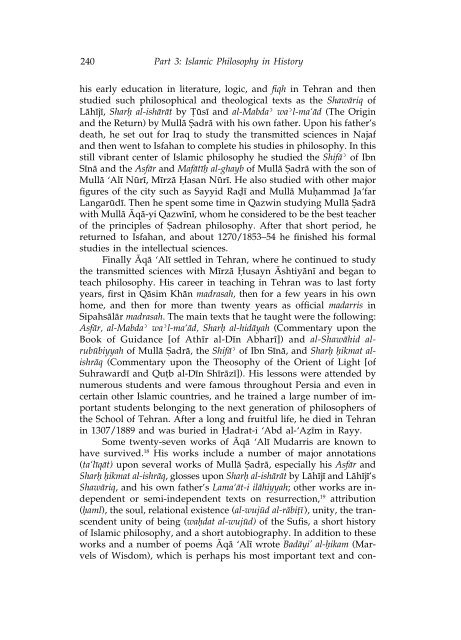Islamic Philosophy from Its Origin to the Present: Philosophy in the ...
Islamic Philosophy from Its Origin to the Present: Philosophy in the ...
Islamic Philosophy from Its Origin to the Present: Philosophy in the ...
Create successful ePaper yourself
Turn your PDF publications into a flip-book with our unique Google optimized e-Paper software.
240 Part 3: <strong>Islamic</strong> <strong>Philosophy</strong> <strong>in</strong> His<strong>to</strong>ry<br />
his early education <strong>in</strong> literature, logic, and fiqh <strong>in</strong> Tehran and <strong>the</strong>n<br />
studied such philosophical and <strong>the</strong>ological texts as <strong>the</strong> Shawåriq of<br />
Låh¥j¥, Shar÷ al-ishåråt by apple¨s¥ and al-Mabda˘ wa˘l-ma‘åd (The <strong>Orig<strong>in</strong></strong><br />
and <strong>the</strong> Return) by Mullå |adrå with his own fa<strong>the</strong>r. Upon his fa<strong>the</strong>r’s<br />
death, he set out for Iraq <strong>to</strong> study <strong>the</strong> transmitted sciences <strong>in</strong> Najaf<br />
and <strong>the</strong>n went <strong>to</strong> Isfahan <strong>to</strong> complete his studies <strong>in</strong> philosophy. In this<br />
still vibrant center of <strong>Islamic</strong> philosophy he studied <strong>the</strong> Shifå˘ of Ibn<br />
S¥nå and <strong>the</strong> Asfår and Mafåt¥÷ al-ghayb of Mullå |adrå with <strong>the</strong> son of<br />
Mullå ‘Al¥ N¨r¥, M¥rzå ¡asan N¨r¥. He also studied with o<strong>the</strong>r major<br />
figures of <strong>the</strong> city such as Sayyid Ra∂¥ and Mullå Mu±ammad Ja‘far<br />
Langar¨d¥. Then he spent some time <strong>in</strong> Qazw<strong>in</strong> study<strong>in</strong>g Mullå |adrå<br />
with Mullå ≈qå-yi Qazw¥n¥, whom he considered <strong>to</strong> be <strong>the</strong> best teacher<br />
of <strong>the</strong> pr<strong>in</strong>ciples of |adrean philosophy. After that short period, he<br />
returned <strong>to</strong> Isfahan, and about 1270/1853–54 he f<strong>in</strong>ished his formal<br />
studies <strong>in</strong> <strong>the</strong> <strong>in</strong>tellectual sciences.<br />
F<strong>in</strong>ally ≈qå ‘Al¥ settled <strong>in</strong> Tehran, where he cont<strong>in</strong>ued <strong>to</strong> study<br />
<strong>the</strong> transmitted sciences with M¥rzå ¡usayn ≈shtiyån¥ and began <strong>to</strong><br />
teach philosophy. His career <strong>in</strong> teach<strong>in</strong>g <strong>in</strong> Tehran was <strong>to</strong> last forty<br />
years, first <strong>in</strong> Qåsim Khån madrasah, <strong>the</strong>n for a few years <strong>in</strong> his own<br />
home, and <strong>the</strong>n for more than twenty years as official madarris <strong>in</strong><br />
Sipahsålår madrasah. The ma<strong>in</strong> texts that he taught were <strong>the</strong> follow<strong>in</strong>g:<br />
Asfår, al-Mabda˘ wa˘l-ma‘åd, Shar÷ al-hidåyah (Commentary upon <strong>the</strong><br />
Book of Guidance [of Ath¥r al-D¥n Abhar¥]) and al-Shawåhid alrub¶biyyah<br />
of Mullå |adrå, <strong>the</strong> Shifå˘ of Ibn S¥nå, and Shar÷ ÷ikmat alishråq<br />
(Commentary upon <strong>the</strong> Theosophy of <strong>the</strong> Orient of Light [of<br />
Suhraward¥ and Qu†b al-D¥n Sh¥råz¥]). His lessons were attended by<br />
numerous students and were famous throughout Persia and even <strong>in</strong><br />
certa<strong>in</strong> o<strong>the</strong>r <strong>Islamic</strong> countries, and he tra<strong>in</strong>ed a large number of important<br />
students belong<strong>in</strong>g <strong>to</strong> <strong>the</strong> next generation of philosophers of<br />
<strong>the</strong> School of Tehran. After a long and fruitful life, he died <strong>in</strong> Tehran<br />
<strong>in</strong> 1307/1889 and was buried <strong>in</strong> ¡adrat-i ‘Abd al-‘Aπ¥m <strong>in</strong> Rayy.<br />
Some twenty-seven works of ≈qå ‘Al¥ Mudarris are known <strong>to</strong><br />
have survived. 18 His works <strong>in</strong>clude a number of major annotations<br />
(ta‘l¥qåt) upon several works of Mullå |adrå, especially his Asfår and<br />
Shar÷ ÷ikmat al-ishråq, glosses upon Shar÷ al-ishåråt by Låh¥j¥ and Låh¥j¥’s<br />
Shawåriq, and his own fa<strong>the</strong>r’s Lama‘åt-i ilåhiyyah; o<strong>the</strong>r works are <strong>in</strong>dependent<br />
or semi-<strong>in</strong>dependent texts on resurrection, 19 attribution<br />
(÷aml), <strong>the</strong> soul, relational existence (al-wuj¶d al-råbi†¥), unity, <strong>the</strong> transcendent<br />
unity of be<strong>in</strong>g (wa÷dat al-wuj¶d) of <strong>the</strong> Sufis, a short his<strong>to</strong>ry<br />
of <strong>Islamic</strong> philosophy, and a short au<strong>to</strong>biography. In addition <strong>to</strong> <strong>the</strong>se<br />
works and a number of poems ≈qå ‘Al¥ wrote Badåyi’ al-÷ikam (Marvels<br />
of Wisdom), which is perhaps his most important text and con-

















